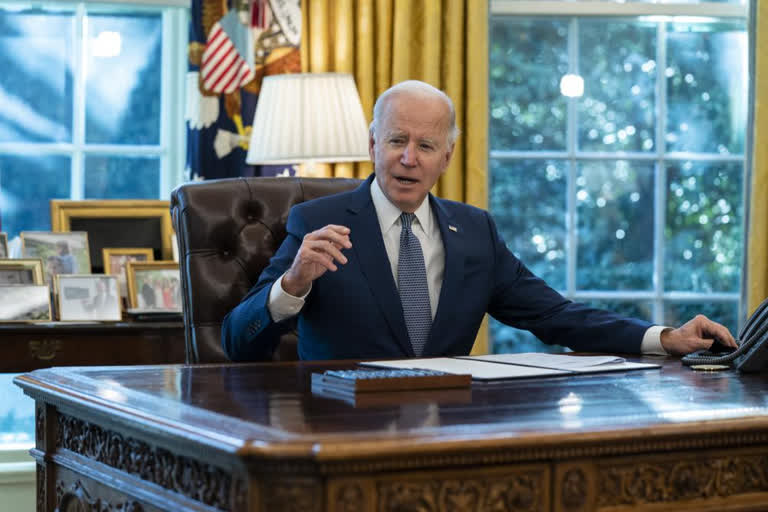Washington:Joe Biden’s long arc in public life has always had one final ambition: to sit behind the Resolute Desk of the Oval Office. He achieved it — albeit, at 78, as the oldest person to assume the presidency. After the turbulence and chaos of his predecessor, Donald Trump, Biden was seen by voters as one who could restore a sense of normalcy and a reassuring tone to the White House.
But Biden also found out, as all his predecessors have, that events beyond his control would shape his time in office and the public’s assessment of him. Takeaways from The Associated Press’ White House team on Biden’s first year as president:
BIG AMBITIONS
Biden started his presidency with more than $4 trillion worth of big ideas — his eyes larger than what the Senate could stomach.
$1.9 trillion worth of coronavirus relief passed in March, which in many first years in office would have been considered a signature achievement.
But Biden kept asking for more: an additional $2.3 trillion for infrastructure and jobs, and another $1.8 trillion for families.
After some tortuous negotiations, he got a version of his infrastructure plan passed and even got more than a dozen Republicans in the Senate to vote for it.
But attention spans are short. Biden’s $1.8 trillion package, which he labeled “Build Back Better,” had elements that included a wish list of Democratic priorities for the past decade — a child care tax credit, climate legislation, paid family leave and universal prekindergarten, among other provisions.
So far, it looks like the bill was not, to turn the expression on its head, too big to fail. Republicans abandoned him on this, and several Democrats were also skeptics. Then inflation surged, and the plan’s chances plummeted.
— By Josh Boak
HE STILL THINKS LIKE A SENATOR
Biden was a senator for nearly four decades, so it’s perhaps no surprise that he brings a legislator’s mindset to his presidency.
Known as as adept negotiator from his time in the Senate, Biden still immerses himself in legislative negotiations and is versed in the minutiae of his proposals. He believes in the value of personal connections and face-to-face conversations in negotiating details, frequently calling key senators or having lawmakers meet with him at the White House.
Biden emphasizes the need for bipartisanship, a value he held dear in the Senate. But it’s one that, in today’s sharply divided Washington, feels out of touch with the moment.
Biden also keeps the schedule of a senator: He’s often late to events and likes to get out of town on the weekends, returning home to Delaware.
One major difference? Now he’s riding Air Force One instead of Amtrak.
— By Alexandra Jaffe
SHOOTING HIGH AND FALLING SHORT
Biden inherited a long list of unfulfilled Democratic policy priorities when he took office, but despite his best efforts, most remain so.
Taking office after Trump’s efforts to subvert the will of voters, no issue seemed so urgent for Biden as the push for legislation on voting protections.
Biden’s attempt to break a logjam on the legislation by pushing for the Senate to change its rules to pass bills by a simple majority was quashed before it even really began by two moderate members of his own party.
It was emblematic of how Biden’s central rationale for his presidency — his nearly four decades in Washington uniquely positioned him to deliver on an immensely ambitious agenda — seems increasingly out of step with today’s politics.
Biden bet unsuccessfully that personal relationships, private cajoling and public arm-twisting could overcome years of increasingly bitter partisan divisions and ideological disagreements.
The lack of progress on voting rights, immigration, climate change, gun control and abortion protections remains an unmet burden.
— By Zeke Miller
NO OBAMA 2.0
Biden came to office trumpeting “America is back,” his shorthand message to allies and adversaries that the days of Trump’s inward-looking “America first” foreign policy were over.
But his approach to the world has also been notable for its determination to avoid some of the missteps of his old boss, Barack Obama.
Biden stood by his pledge to meet an August deadline to end the war in Afghanistan even as military commanders and some political allies urged him to slow down what ended up being a chaotic and bloody U.S. military withdrawal. As vice president, Biden had opposed Obama’s move to surge more U.S. troops into the country. But the exit Biden presided over was widely criticized for its haste and execution, which included U.S. troop casualties.
Biden also came to office with a greater deal of skepticism than Obama — and Trump and George W. Bush for that matter — about Russian President Vladimir Putin. Obama sought to “reset” the U.S.-Russia relationship. By 2014, after a series of earlier disappointments, Obama’s hope for a reset had evaporated when Russia seized the Black Sea peninsula of Crimea from Ukraine.
Biden made it clear early on that his highest hope for the Putin relationship was finding a measure of stability and predictability. With his administration pressing Putin to step back from Russia’s current troop buildup on the Ukraine border, it remains to be seen if Biden’s approach will net better results.
